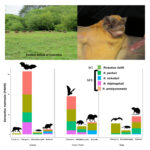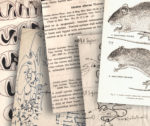Rickettsia spp. seroprevalence in wild mammals from Arauca, Orinoquia region of Colombia
Daniela Velásquez-Guarín, Jorge E. Pérez Cárdenas, Maria Carolina A. Serpa, Marcelo B. Labruna, Álvaro A. Faccini-Martínez, Fredy A. Rivera-Páez, Héctor E. Ramírez-ChavesRickettsia includes pathogenic bacteria that commonly use mammals as reservoirs and amplifying hosts. In Colombia, the knowledge about mammals as reservoirs of these bacteria is limited, even in areas considered endemic regions for spotted fever group (SFG) rickettsiae. To identify wild mammals acting as potential reservoirs of Rickettsia spp., we collected blood from 573 individuals captured in the Orinoquia of Colombia and processed it to obtain serum (n = 351) and DNA (n = 250). The serum was evaluated using indirect immunofluorescence assays (IFA) for the detection of IgG antibodies to four SFG rickettsiae antigens (Rickettsia rickettsii, R. parkeri, R. amblyommatis, R. rhipicephali), and R. bellii of the Ancestral group (AG). We amplified a fragment of the rickettsial citrate synthase gene (gltA) to detect Rickettsia from blood samples. The IFA showed seropositivity in 122 individuals of 20 mammalian species. IgG antibodies titers to Rickettsia spp., at a cutoff of ≥ 1:64, were 70.49% in bats (n = 86), 21.31% in rodents (n = 26), 7.38% in marsupials (n = 9), and 0.82% in carnivores (n = 1). The potential antigens involved in a homologous reaction (PAIHR) were R. bellii (18.85%), R. amblyommatis (9.01%), R. rhipicephali (4.91%), R. rickettsii (4.91%), and R. parkeri (4.09%), respectively. Bats were the most seropositive hosts, with antibodies to different Rickettsia antigens. We detected Rickettsia in 2.8% of the DNA samples (n = 5) from rodents, bats, and marsupials, but we could not confirm the molecular identity of Rickettsia. The presence of antibodies indicated a possible exposure of the evaluated mammals to SFG and AG rickettsiae and supported that the Orinoco Region must be considered endemic for SFG rickettsiae.
Seroprevalencia de Rickettsia spp. en mamíferos silvestres de Arauca, región de la Orinoquia de Colombia. Rickettsia incluye bacterias patógenas que comúnmente utilizan a los mamíferos como reservorios y hospedadores amplificadores. En Colombia, el conocimiento sobre mamíferos reservorios de estas bacterias es limitado, incluso en áreas consideradas endémicas para rickettsias del grupo de las fiebres manchadas (GFM). Para identificar aquellos mamíferos silvestres que actúan como reservorios potenciales de Rickettsia spp., recolectamos muestras de sangre de 573 individuos capturados en la Orinoquia de Colombia y las procesamos para obtener suero (n = 351) y ADN (n = 250). El suero se evaluó mediante ensayos de inmunofluorescencia indirecta (IFA) para la detección de anticuerpos IgG contra cuatro antígenos de rickettsias del GFM (Rickettsia rickettsii, R. parkeri, R. amblyommatis, R. rhipicephali) y R. bellii del grupo Ancestral (GA). Además, amplificamos un fragmento del gen rickettsial citrato sintasa (gltA) para detectar Rickettsia spp. a partir de muestras de sangre total. Los resultados de IFA mostraron seropositividad en 122 individuos de 20 especies de mamíferos. Los títulos de anticuerpos IgG contra Rickettsia spp., en un punto de corte de ≥ 1:64, fueron 70,49% en murciélagos (n = 86), 21,31% en roedores (n = 26), 7,38% en marsupiales (n = 9), y 0,82% en carnívoros (n = 1). Los posibles antígenos implicados en una reacción homóloga (PAIHR) fueron R. bellii (18,85%), R. amblyommatis (9,01%), R. rhipicephali (4,91%), R. rickettsii (4,91%) y R. parkeri (4,09%), respectivamente. Los murciélagos fueron los hospedadores más seropositivos, con presencia de anticuerpos contra diferentes antígenos de Rickettsia. Detectamos Rickettsia en el 2,8% de las muestras de ADN (n = 5) de roedores, murciélagos y marsupiales, pero no fue posible confirmar la identidad molecular de estas. La presencia de anticuerpos indica una posible exposición de los mamíferos evaluados a las rickettsias del GFM y GA, y dan un soporte a que la Orinoquia debe ser considerada endémica para rickettsias del GFM.

